 Children should not start formal education (that’s sitting down to read, write do maths etc) until they are at least six. So says the devastating attack on our schooling by the largest study of Primary Education for 40 years.
Children should not start formal education (that’s sitting down to read, write do maths etc) until they are at least six. So says the devastating attack on our schooling by the largest study of Primary Education for 40 years.
The Cambridge Primary Review, led by Professor Robin Alexander recommends putting us in line with the rest of Europe by continuing with the play based learning which now goes on in Nurseries and Reception classes for at least another year.
They argue that many children are introduced to formal reading and writing before they are ready and are ‘turned off’ by a lack of success.
There is certainly a great deal to be said for this approach, as our European counterparts, including Wales, seem to be much more successful with educating their children. Many four and five year olds have not developed sufficiently to be taught to read and write at 5. They immediately start to fail, this leads to disenchantment and a negative attitude to the next 10 years of school life. It really is a waste of time and effort trying to teach children before they have matured sufficiently to understand the concepts involved.
The survey also calls for the abandonment of the SATs, claiming they are too narrow and not fit for purpose. Unfortunately, the Government do not appear to be listening.
Month: October 2009
Coming soon: Fractions, division and number squares
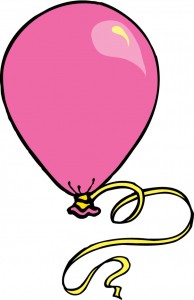 Understanding equivalence in fractions is probably the key which opens the door to understanding the whole world of fractions. One of the first things to remember about equivalence is that the larger the number on the bottom of the fraction, the smaller each part of the fraction is. So 4/100 is much smaller than 4/25. Also it is much easier to compare the size of two fractions if the bottom numbers are the same. Next week we look further at these ideas with a year 4 equivalent fractions worksheet.
Understanding equivalence in fractions is probably the key which opens the door to understanding the whole world of fractions. One of the first things to remember about equivalence is that the larger the number on the bottom of the fraction, the smaller each part of the fraction is. So 4/100 is much smaller than 4/25. Also it is much easier to compare the size of two fractions if the bottom numbers are the same. Next week we look further at these ideas with a year 4 equivalent fractions worksheet.
By year 5 solving division problems ‘in your head’ get quite tricky and a very good understanding of the relationship between multiplication and division is needed. We also will be publishing a page with questions involving sharing with remainders, which need both working out ‘tables’ and calculating the number left over.
Also coming up soon is a further look at number squares for Year 2 children and is excellent practice at understanding place value as well as counting. A small section of the whole number square, just 4 by 3 is taken and most of the numbers removed. The skill is in replacing the missing numbers.
Year 6 Maths Worksheet: rounding decimals
 The second in our series on rounding decimals for year 6, this worksheet looks at rounding to the nearest whole number and to the nearest tenth.
The second in our series on rounding decimals for year 6, this worksheet looks at rounding to the nearest whole number and to the nearest tenth.
When rounding to the nearest whole number, the crucial digit to look at is the tenths digit. If it is 5 or more then the units will round up; if it is less than 5 the units will remain the same.
When rounding to the nearest tenth the crucial digit to look at is the hundredth.
Difficulties can occur when a number that needs rounding up also changes the units and possibly the tens digits. For example 9.95 rounded up to the nearest tenth is 10.
Resource of the Week: Year 5 Scalene triangles
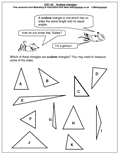 A lot of work is done on triangles in Primary Schools and by year 5 and 6 most children are familiar with the properties of right angled triangles, equilateral triangles and isosceles trinagles. However, fewer children know about the scalene triangle. A scalene triangle is one which has no sides the same length and no equal angles. Right angled triangles could also be scalene if all the sides are different lengths.
A lot of work is done on triangles in Primary Schools and by year 5 and 6 most children are familiar with the properties of right angled triangles, equilateral triangles and isosceles trinagles. However, fewer children know about the scalene triangle. A scalene triangle is one which has no sides the same length and no equal angles. Right angled triangles could also be scalene if all the sides are different lengths.
Thanks to MathSphere Ltd for this worksheet: and there are many more similar pages, both on their site and part of the ‘It’s All Figured Out’ CD.
Year 4 Maths Worksheet: division problems (pg 1)
Division problems worksheet
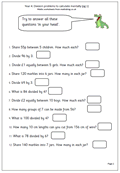 Solving division problems ‘in your head’ can often prove to be tricky and a good knowledge of tables and multiplication facts is needed.
Solving division problems ‘in your head’ can often prove to be tricky and a good knowledge of tables and multiplication facts is needed.
Here we have a set of questions all involving mental division.
There are a number of different skills which can be used to answer them. For example, dividing by 4 can be achieved by halving and halving again. Dividing £1 between 5 involves converting the £1 into 00p first.
Perhaps the trickiest question asks how many 10 cm lengths of wire can be cut from 156 cm of wire; of course there will be some left over, which in the context of the question can be ignored.
Year 4 maths worksheet: equivalent fractions, halves
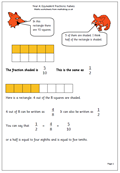 One of the hardest ideas to get over to children is equivalent fractions, but it is one of the most vital. These pages look at some of the easier equivalence, using sixths, eighths and tenths and relating them to halves. It is a good idea to have as much practical work as possible, either shading in or cutting into pieces. The aim is for the child to see a developing pattern of numbers: if the numerator doubles and the denominator also doubles then the fractions will remain equal. Tricky, as children are unused to the idea of different numbers being equal to each other.
One of the hardest ideas to get over to children is equivalent fractions, but it is one of the most vital. These pages look at some of the easier equivalence, using sixths, eighths and tenths and relating them to halves. It is a good idea to have as much practical work as possible, either shading in or cutting into pieces. The aim is for the child to see a developing pattern of numbers: if the numerator doubles and the denominator also doubles then the fractions will remain equal. Tricky, as children are unused to the idea of different numbers being equal to each other.
These pages can be found in our Year 4 resources, under Counting and Number.
Coming soon: fractions, decimals and division
 It’s up, up and away with some quite tricky subjects coming up next week, including division, decimals and fractions. One of the hardest ideas to get over to children is equivalent fractions, but it is one of the most vital. We have a year 4 worksheet which looks at some of the easier equivalence, using sixths, eighths and tenths and relating them to halves. It is a good idea to have as much practical work as possible, either shading in or cutting into pieces.
It’s up, up and away with some quite tricky subjects coming up next week, including division, decimals and fractions. One of the hardest ideas to get over to children is equivalent fractions, but it is one of the most vital. We have a year 4 worksheet which looks at some of the easier equivalence, using sixths, eighths and tenths and relating them to halves. It is a good idea to have as much practical work as possible, either shading in or cutting into pieces.
Solving division problems ‘in your head’ can often prove to be tricky and a good knowledge of tables and multiplication facts is needed, but it is surprsing how many different strategies we use when working mentally.
We also have the second in our series on rounding decimals for year 6; this worksheet will look at rounding to the nearest whole number and to the nearest tenth.
Times tables and square numbers
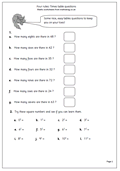 Rather a mixed bag of questions here. The first half asks questions derived from the times tables, such as ‘How many fours in 32?’ This is an important question to ask before moving on to the long method of division.
Rather a mixed bag of questions here. The first half asks questions derived from the times tables, such as ‘How many fours in 32?’ This is an important question to ask before moving on to the long method of division.
The second set of questions looks at square numbers, which, of course, give a diagonal pattern on a tables square. Children need to be familiar with the square sign to tackle this. It is extremely useful to know, off by heart, all the square numbers, up to at least 10 x 10, as it will be a great help later in High School.
This page can be found in our Four Rules section, under Multiplication (mental methods).
Resource of the Week: Maths wordsnake
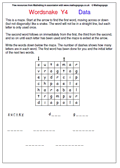 In our Puzzles section we have a number of great activities related to maths. Some of these are quite tricky, including the Wordsnakes.
In our Puzzles section we have a number of great activities related to maths. Some of these are quite tricky, including the Wordsnakes.
A Wordsnake is a little like a maze of letters. Start at the arrow to find the first word, moving across or down the grid of letters (but not diagonally) like a snake. The word will not be in a straight line but each letter in the grid can only be used once. The second word follows on immediately from the first, the third from the second and so on until each letter has been used and the maze is exited at the second arrow.
On this Wordsnake the first word has been done for you and the number of dashes shows how many letters there are in each word. As it is about data handling all the words are to do with this. Still not clear? Why not have a go as it is testing even for adults!
More maths games can be found in our Puzzles section
Read the time to the half or quarter hour
 Reading the time on an analogue clock face can prove very tricky for many children, especially if they have learning difficulties such as dyslexia. The problems usually occur when the minute hand has gone past the half hour so that we are looking forward to the next hour (eg a quarter to 9) rather than minutes past. We could say 45 minutes past 8, as it is technically correct, but no-one does! To complicate things even more, we do say 8:45 (eight forty five) when reading a digital clock!
Reading the time on an analogue clock face can prove very tricky for many children, especially if they have learning difficulties such as dyslexia. The problems usually occur when the minute hand has gone past the half hour so that we are looking forward to the next hour (eg a quarter to 9) rather than minutes past. We could say 45 minutes past 8, as it is technically correct, but no-one does! To complicate things even more, we do say 8:45 (eight forty five) when reading a digital clock!
This page, which can be found in Year 2 measures, just looks at quarter and half hours and can be used as a quick guide as to whether your child has grasped the concept.